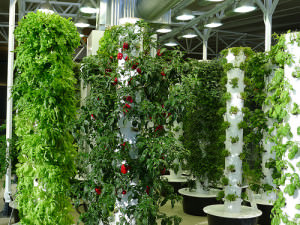The Rise of Urban Farming in North America
This isn’t just a farm, but a job for these young people.”
[pullquote]Vertical farming helps protect crops by housing them in an indoor environment, protecting them from the negative effects of nature while still continuing to reap its benefits.[/pullquote]
A project such as this community farm will give the youth of this community as sense of ownership that could potential inspire them to dream big and understand what can come from hard work. The New York City housing authority is expected to monitor the project, and hopes to expand the project to four other housing communities within the city.
Vertical farming and its growing impact
Another project that is bringing farming into the urban fold is called Vertical Farming, and there are a few examples right in our own backyard.
Dr. Dickson Despommier has been attempting to answer the question of how we are to feed our growing population during a time period in which urban ecosystems are taking over rural farmland. It is believed that over 80% of farmable land is already in use, and that the remaining 20% with not adequately feed our growing population.
This concept of indoor farming has been around for some time, but on a much smaller scale. However, with demand increasing for food, the need to scale up the production is upon us.
“The biggest social benefit is that everyone gets fed,” says Despommier. “All the water is recycled, all the nutrients are recycled. All that leaves the building is the produce.”
Natural events in our environments, such as the flooding currently going on in Western Canada, represent just how fast a good crop can be taken away from us. Vertical farming helps protect crops by housing them in an indoor environment, protecting them from the negative effects of nature while still continuing to reap its benefits.
Alterrus System, a Vancouver-based company, became the first North American Company to implement the vertical-farming technology when they redesigned the top floors of a Vancouver parking lot.

Image courtesy of chipmunk_1 via Flickr
“The VertiCrop technology represents a radical shift in sustainable food production,” said Christopher Ng, Alterrus CEO. “Current food-production methods are ineffective in dealing with the challenges of growing populations and decreasing amounts of farmland. VertiCrop’s high-density urban farming is an effective way to grow nutritious food using fewer land and water resources than traditional field-farming methods.”
Perhaps it isn’t so much that North American agriculture is dying out, but more so that it is changing, much like it has in the past. Innovation such as steam power changed the ways farmlands were cropped. As these examples show, the end of rural farming should not be feared, but embraced.
Spencer Emmerson is a freelance writer based in Toronto, Ontario. In October of 2012, he obtained his Honours degree in English from the University of Guelph. To learn more, please view his twitter account @TheSpinner24.
Source
Image courtesy of MMW Horticulture Group via Flickr
Image courtesy of chipmunk_1 via Flickr
Urban-Rural Connections: A Review of the Literature by Elizabeth Mylott
Vertical Farming
Stats Canada
The Daily Mail: The Plant Skyscrapers
North America’s First Vertical Urban Farm is Being Built in Canada
Brooklyn’s largest public housing development gets urban farm
Red Hook Houses to grow jobs, produce






























Share the post "The Rise of Urban Farming in North America"